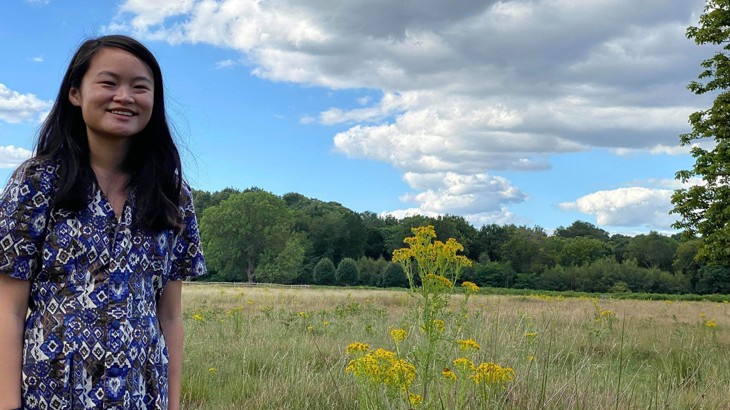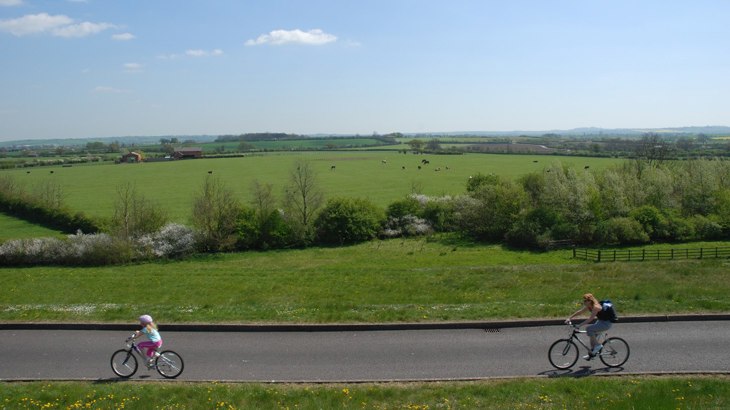Carmen Szeto is Senior Network Development Manager in our England Midlands & East team. As part of her role, she maintains and improves the popular Lias Line in Warwickshire. Here she talks about her experiences of working on the route during lockdown and explains why coronavirus means we need more, not less, investment in greenways and active travel.

Carmen (pictured here) joined Sustrans earlier this year and was excited to get to work on improving the Lias Line.
When I started work at Sustrans earlier this year, I was so excited at the prospect of working on the Lias Line.
Even compared to the other exciting projects to improve the National Cycle Network it’s inspiring!
Winding its way through the rural Warwickshire countryside, it takes in a number of local beauty spots, including Draycote Water.
What makes the Lias Line so special?
Running along the trackbed of an abandoned train line from the 1960s, it’s also a great way to get across the county.
The ‘Lias Line’ takes its name from the Blue Lias limestone found underneath the ground locally.
This local bedrock spawned a local cement industry along with many impressive fossil finds.
Route 41, as it’s officially signed, was identified in last year’s Paths for Everyone report as a priority for improvement.
With funding from the Department for Transport, we hope to connect the communities of Leamington Spa, Rugby and Model Village.
A wildlife haven
As a greenway, it will also become a haven for wildlife giving locals the chance to explore more of the Warwickshire countryside.
The entirety of the Line is approximately 10.5km long and spans a variety of habitats.
From ponds with Great Crested Newts and underwater creatures along the River Leam to badger setts and butterflies fluttering in grasslands, there will be plenty to discover when the Line opens!
Clearing the route
If you were in the area in March, you may have seen some of our expert team clearing vegetation along the route.
That’s because after the railway line was decommissioned in the 1960s, trees such as oak and ash trees began naturally regenerating.
Over time, trees began encroaching into the grassland sections of the Line making it harder to navigate.
So far so good then?
Of course, by the end of March, all that work had to stop because of coronavirus.
Like everything else, the Lias Line was plunged into a state of lockdown.
We had to abandon work because social distancing was just too difficult to maintain.
Using the lockdown to the route's advantage
So with the limits imposed on us, we’ve tried to use the time as productively as possible. And it’s been a really good time to catch up on planning and finalising the design.
Thankfully, most of the vegetation clearance had already been completed - which is just as well as we’re now into the bird nesting season.
But the pause has allowed us to see what the Lias Line looks like from the ground up.
With a little help from neighbouring landowners who’ve helped with access to the site, we’ve been carrying out a wildlife survey.
We’re recording natural activity on the line which is enabling us to see what creatures are living there. This will help us to understand how we develop the greenway in future.

The Lias Line has something for everyone. It links Rugby and Leamington Spa, passing through pretty villages, wildlife reserves, reservoirs and canals.
The future of the Lias Line
Looking forward, there’s clearly a long, long way to go in the fight against Covid-19 but things already feel a little better than they were.
Since the lockdown began to ease in May, we’ve been able to return to the site. And we’ve been getting on with the vital process of consultation with key local stakeholders.
For the public, people are no longer limited to just an hour outdoors meaning they can enjoy more of this picturesque route with appropriate social distancing.
Of course, there’s no getting away from the fact that delays have pushed back our completion date but we are, again, making progress.
Changing how we do things for the better
Reflecting on this crazy period has helped me to understand that the virus may be with us for some time so we might need to rethink a lot of things.
The way we work, socialise, travel and use space are all up for debate.
Greenways, such as the Lias Line, provide a high-quality safe space allowing people to socially distance while they travel or just enjoy nature’s show.
They not only help to get people around but to give them access to a high-quality natural environment – vital for health and wellbeing.
Rethinking how we use green spaces
The same is true for cities and other urban areas. We will need to rethink how we use outside spaces as more will be required to allow social distancing.
That means returning road space to pedestrians and cyclists.
For this to work, there will need to be strong political will and support from decision-makers.
I hope that this scheme will be able to play a part in convincing them. Because now more than ever we need investment in active travel and sustainable solutions.





